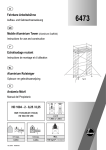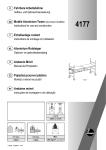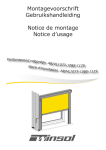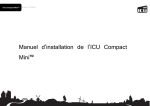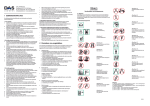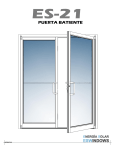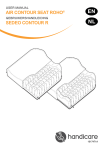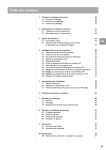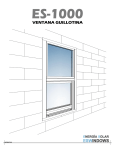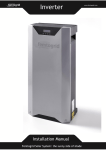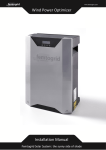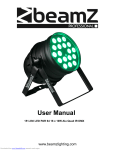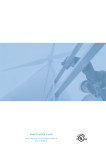Download WORK INSTRUC- TION:
Transcript
WORK INSTRUCTION: Working at elevated heights Rev. 01 HSEQ procedure: Normal business operations Date: 27-02-13 1. General Objective The objective of this procedure is to ensure that working at elevated heights takes place responsibly and to eliminate the risk of falling. Applicability This procedure applies to employees of REC and third parties who carry out work for REC. Definition/Term Description Requesting party Person within REC who requests scaffolding Person who takes delivery of scaffolding Trained person within REC who functionally takes delivery of scaffolding. Work equipment The equipment that is used for the work, such as a stairway, mobile elevating work platform or mobile scaffolding structure. User Person uses the work equipment. Mobile elevating work platform Arm and scissor lifts-are equipped with a guided lifting platform for lifting persons and possibly goods where a risk of falling from a minimum of 3 metres exists. 2. Safety hazards When working at elevated heights, the following risks may apply: Risk of falling from a platform at an elevated height and due to ladders toppling over Risk of restricting blood flow when a person is suspended in a full-body harness for an excessive period of time Risk of pinching and crushing when a person falls between plant components from an elevated height Risk of being thrown out of a man-riding basket when not secured by a safety line Drawn up by: C. Jonkman (HSEQ REC) Approved by: S. Bosch (Operations Director REC ) Digital version: Page 1 of 14 PRINTED VERSION Most recent version: Y:\KAVM\PROCEDURES EN WI\ 648.nl.0.o.Working-at-heights.docx WORK INSTRUCTION: Working at elevated heights Rev. 01 HSEQ procedure: Normal business operations Date: 27-02-13 3. Health hazards Exposure to dust and airborne particles (including micro-organisms) Vapours and gases Exposure to heat 4. Working method and measures The section below describes the procedure for: safe use of steel scaffolding (4.1) ladders and stairways (4.2) mobile scaffolding (4.3) man-riding baskets (4.4) mobile elevating work platforms (4.5) fall protection equipment (4.6) roof edge safety provisions (4.7) washing the windows of the services building (4.8) 4.1 Steel scaffolding Scaffolding that is erected at REC must comply with the Scaffolding Directive. Scaffolding that deviates from this Directive may only be erected based on a TRA and after obtaining the agreement of the Project Manager in the Technical Department and HSEQ adviser. 4.1.1 Issuing an order for construction of scaffolding An order for construction of scaffolding may only be issued by the contact person at REC. The order consists of the following descriptions: The purpose for which the scaffolding will be used (e.g. inspection, hoisting, mounting a pump) Heavy weights that will be supported on the scaffolding floor The dimensions of the scaffolding and the height at which work takes place Whether electrical plant and tools will be used on the scaffolding Any process equipment, walkways and emergency provisions that may not be obstructed Indication of pipes or other plant components that may result in a dangerous situation if broken or damaged during erection of the scaffolding Drawn up by: C. Jonkman (HSEQ REC) Approved by: S. Bosch (Operations Director REC ) Digital version: Page 2 of 14 PRINTED VERSION Most recent version: Y:\KAVM\PROCEDURES EN WI\ 648.nl.0.o.Working-at-heights.docx WORK INSTRUCTION: Working at elevated heights Rev. 01 HSEQ procedure: Normal business operations Date: 27-02-13 Based on the above information, the scaffolding erector determines the required strength for the scaffolding and how the scaffolding should be constructed. The scaffolding erector is responsible for design calculation and structural execution. 4.1.2 Earthing scaffolding All metal parts of steel scaffolding are connected to an earthing cable in accordance with NEN1010 when there are electrical cables or wires on, at the side of, against or above the scaffolding that may be connected to a live electricity network. This relates to the following situations among others: Scaffolding in transformer and electrical plant rooms Scaffolding on which machines are used or where electricity cables fused at ≥ 32 mA are present Places where static electricity and electrical discharge may cause an explosion (EX zones) NB: If in doubt, the person responsible for the plant should be consulted. The earthing resistance must be less than 50 ohms. The requesting party ensures that the scaffolding is earthed and tested by a professionally qualified person appointed by the person responsible for the plant. The resistance measured in the earthing line is recorded by the professionally qualified person on the scaffolding acceptance form or scaffolding card. 4.1.3 Reporting scaffolding as ready for use and acceptance of scaffolding When a scaffolding structure is ready for use, the following procedure must be followed: The scaffolding erector has the scaffolding technically inspected and structurally validated by a person who has not been involved in its erection. Depending on the complexity, a scaffolding structure may need to be approved by a scaffolding inspector. A checklist is filled in at the time of (part) delivery (see Scaffolding Directive). Following approval, the scaffolding erector contacts the person taking delivery and reports that the scaffolding structure is ready for use. The person taking delivery checks the following safety aspects at the time of handover of the scaffolding structure: 1. is the scaffolding structure suitable for the work that is to be carried out? 2. are the work platforms fitted with guard rails? 3. are the work platform floors fitted with edging boards? 4. are the work platforms safe to walk on? 5. are the ladders secured at an angle of ± 70°? 6. does the ladder protrude at least 1 metre above the work platform floor? Drawn up by: C. Jonkman (HSEQ REC) Approved by: S. Bosch (Operations Director REC ) Digital version: Page 3 of 14 PRINTED VERSION Most recent version: Y:\KAVM\PROCEDURES EN WI\ 648.nl.0.o.Working-at-heights.docx WORK INSTRUCTION: Working at elevated heights Rev. 01 HSEQ procedure: Normal business operations Date: 27-02-13 After the scaffolding structure has been accepted by the person taking delivery, an approval label (scafftag) will be attached to all the access stairways (this label reads: “SCAFFOLDING READY FOR USE” (or similar). The following information must be noted on the approval label: 1. date on which the scaffolding structure is handed over to the person taking delivery 2. date on which the scaffolding structure was last inspected 3. scaffolding erector's name + signature 4. name of the person taking delivery + signature 5. maximum floor load 6. “Non-compliant scaffolding” in the case of scaffolding that does not comply with the Scaffolding Directive 4.1.4 Using the scaffolding structure A SCAFFOLDING STRUCTURE MAY NOT BE ASCENDED/WALKED ON WITHOUT AN APPROVAL LABEL! Before the user climbs onto a scaffolding structure, he must inspect the scaffolding visually for faults. He checks the scaffolding based on the following safety aspects: Is the approval label attached? Is the scaffolding stable? Are the work platforms safe to walk on? Are the floors of the work platforms free of gaps and holes and fitted with edging boards? Are the work platforms fitted with guard rails? Have any scaffolding parts been removed (insofar as recognisable)? 4.1.5 Dismantling scaffolding The same scaffolding erector who built the scaffolding should preferably dismantle the scaffolding. The procedure for dismantling is as follows: The requesting party issues written instructions requesting the scaffolding erector to have the scaffolding dismantled The scaffolding erector removes the approval label The scaffolding is dismantled in a way that does not put persons or plant at risk Allowing material to fall to the ground when dismantling the scaffolding is not permitted Drawn up by: C. Jonkman (HSEQ REC) Approved by: S. Bosch (Operations Director REC ) Digital version: Page 4 of 14 PRINTED VERSION Most recent version: Y:\KAVM\PROCEDURES EN WI\ 648.nl.0.o.Working-at-heights.docx WORK INSTRUCTION: Working at elevated heights Rev. 01 HSEQ procedure: Normal business operations Date: 27-02-13 4.1.6 Altering scaffolding Alterations to scaffolding, such as removing support beams or floor elements may only be carried out by the scaffolding erector. If a scaffolding component needs to be removed temporarily, for example when installing a pipe, the scaffolding correction coordinator issues an order for the alteration to the scaffolding erector. The scaffolding erector assesses whether the alteration is possible within the existing scaffolding configuration. 4.1.7 Qualifications required by the scaffolding erector and person taking delivery The following qualification requirements apply for the erection of scaffolding: A person who erects, alters or dismantles simple scaffolding structures must be in possession of the Dutch “Steigerbouwer A” (Scaffolding Erector A) certificate A person who erects, alters or dismantles complex scaffolding structures must be in possession of the Dutch “Steigerbouwer B” (Scaffolding Erector B) certificate Erecting, altering and dismantling a scaffolding structure must be supervised by a scaffolding erector who is in possession of the Dutch “Steigerbouwer B en/of Voorman steigerbouw” (Scaffolding Erector B and/or Scaffolding Erection Foreman) certificate The following qualification requirements apply for technically taking delivery of scaffolding: A person who technically takes delivery of a complex scaffolding structure is in possession of the Dutch “Steigerinspecteur” (Scaffolding Inspector) certificate A person who technically takes delivery of a simple scaffolding structure is in possession of the Dutch “Veiligheidsbeoordeling Steigers 2” (Safety Assessment of Scaffolding 2) certificate The following qualification requirements apply for functionally taking delivery of scaffolding: The person who functionally takes delivery of a complex scaffolding structure is in possession of the Dutch “Veiligheidsbeoordeling Steigers 1” (Safety Assessment of Scaffolding 1) certificate The person who takes delivery of a simple scaffolding structure has attended the Dutch “functioneel afname eenvoudige steigers” (taking delivery of simple scaffolding structures) training course 4.1.8 Storing scaffolding materials Placing scaffolding materials for direct use on platforms and landings must take place in such a way that these materials cannot fall and/or place excessive loads on the structure. Platforms may not be obstructed by (scaffolding) material (escape route). Scaffolding material must be stored at the designated storage location. Surplus scaffolding material must be removed from the scaffolding floor before the scaffolding structure is approved for use. Drawn up by: C. Jonkman (HSEQ REC) Approved by: S. Bosch (Operations Director REC ) Digital version: Page 5 of 14 PRINTED VERSION Most recent version: Y:\KAVM\PROCEDURES EN WI\ 648.nl.0.o.Working-at-heights.docx WORK INSTRUCTION: Working at elevated heights Rev. 01 HSEQ procedure: Normal business operations Date: 27-02-13 4.1.9 Use of a full-body harness When erecting and dismantling a scaffolding structure, all scaffolding erectors must wear a full-body harness and attach a safety line when working above a height of 2.5 metres. The full-body harness should preferably be fitted with a fall arrester or attached to dual safety lines. 4.1.10 Protection against falling objects Before a scaffolding structure can be erected or dismantled, the scaffolding erector must, in consultation with the requesting party, take any action required to protect persons and vulnerable items and plant (cordoning off the work area and protecting equipment). The size of any barriers must be agreed with the manager responsible for the area where the scaffolding structure is erected. 4.1.11 Free passage and emergency exits/escape routes Landings, stairways incorporating landings, escape routes and safe walking routes may not be obstructed by scaffolding and/or scaffolding material. If a scaffolding structure has to be installed in these areas, an emergency exit must be provided in the scaffolding structure. The requesting party must indicate this to the scaffolding erector so that allowance for this can be made in the scaffolding erector's stress calculations. Essential control equipment, fire extinguishing systems/fire hoses and emergency showers/eye washes must also be kept unobstructed. If this is not possible, alternative facilities must be indicated in a TRA. 4.1.12 Complex scaffolding structures The following rules apply for the erection of complex scaffolding structures: the scaffolding erector must always perform an additional structural strength calculation in accordance with NEN-EN 12810-2. The following are examples of complex scaffolding structures: Scaffolding structures of more than 30 metres in height. Scaffolding structures that are constructed in boiler sections where the supporting surface is not horizontal. Support scaffolding. Scaffolding structures to which fabric sheets or tarpaulins are attached (wind load). Scaffolding structures fitted with a protruding extension. Scaffolding structures to which a hoist must be attached. Suspended scaffolding structures that are attached to building elements. 4.1.13 Safety check The scaffolding structure is checked for faults by the scaffolding erector every two weeks. He must also inspect the scaffolding after any incidents that may have affected the scaffolding's structural integrity. Each inspection is noted on the approval label in the form of a date and name. Drawn up by: C. Jonkman (HSEQ REC) Approved by: S. Bosch (Operations Director REC ) Digital version: Page 6 of 14 PRINTED VERSION Most recent version: Y:\KAVM\PROCEDURES EN WI\ 648.nl.0.o.Working-at-heights.docx WORK INSTRUCTION: Working at elevated heights Rev. 01 HSEQ procedure: Normal business operations Date: 27-02-13 After the inspection, the scaffolding erector signs off the approval label again with his name, signature and inspection date. At all events, the scaffolding is re-inspected after a storm, overloading, collision with a vehicle or an incident. 4.1.14 General safety rules The following safety rules apply for working on steel scaffolding at REC: Changing and/or dismantling a scaffolding structure may only be performed by scaffolding erectors! If the scaffolding structure is found to be unsafe, the person making the discovery has a duty to remove the approval label and hand it in to the relevant manager who informs the scaffolding erector Working on ladders or stairways placed on the scaffolding floor is not permitted No auxiliary scaffolding structures higher than 50 cm may be placed on the work floor. An extra handrail or guard barrier must be installed in the same location as the auxiliary scaffolding structure Scaffolding floors may not be subjected to heavier loads than the load specification noted on the approval label Materials on work floors may not be stacked higher than 55 cm Minor items such as bolts, nuts, and hand tools etc must be stored in buckets, crates and/or tool bags. 4.2 Ladders and stairways 4.2.1 Use of ladders and stairways The basic principle when working at elevated height is to minimise the use of ladders. Ladders and/or stairways may only be used for incidental tasks when the use of other work equipment is not feasible for technical, economic and or operational reasons. The following conditions apply to the use of ladders and stairways: The standing height (height of the feet above floor level) is less than 8 metres There are at least three points of contact between the user and the ladder/stairway at all times (e.g. 2 feet and 1 hand) The ladder and/or stairway is not used continuously for more than 5 minutes The maximum force exerted as a result of pulling and/or pushing lies between 5 and 10 kg (no heavy physical work) The maximum reach required is one arm length Ladders or stairways may not be used in cases where the conditions specified above cannot be satisfied. In such cases, safer work equipment such as scaffolding or mobile elevating work platforms must be used. Drawn up by: C. Jonkman (HSEQ REC) Approved by: S. Bosch (Operations Director REC ) Digital version: Page 7 of 14 PRINTED VERSION Most recent version: Y:\KAVM\PROCEDURES EN WI\ 648.nl.0.o.Working-at-heights.docx WORK INSTRUCTION: Working at elevated heights Rev. 01 HSEQ procedure: Normal business operations Date: 27-02-13 4.2.2 General safety rules The following safety rules apply for the use of ladders and/or stairways at REC: A ladder must be positioned so that it: - extends 1 metre above the location to which it provides access - is always secured to prevent it from slipping and/or moving - is set up at an angle between 60° to 70° Before climbing a ladder, check it for visible faults such as loose rungs, missing anti-slip supports and dents Never climb a ladder further than the fourth rung from the top When accessing a roof or platform, the ladder must protrude 1 metre above the roof or platform Three points of contact must be maintained when climbing and/or descending from a ladder The ladder or stairway may not be used by more than one person at the same time Carrying tools and materials up ladders is only permitted in a carry bag or by hoisting the items up from the work platform using a rope If work is carried out on a stairway, no other work may be performed underneath The use of steel and/or aluminium ladders and stairways is not permitted when working in electrical plant rooms (high-voltage and/or low-voltage) where the system is exposed Once positioned, a ladder must be secured to prevent it from falling over and/or blowing over at all times Ladders and/or stairways must be inspected and tested annually. This must be demonstrated by means of an approval sticker or year colour code 4.3 Mobile scaffolding 4.3.1 Use of mobile scaffolding structures A manual must be kept available on site for each mobile scaffolding structure. This manual contains all the relevant information relating to erection, maintenance, safe use and dismantling of mobile scaffolding structures. These rules must be observed. The following information must be displayed clearly and legibly on a mobile scaffolding structure: The load class The maximum erection height The name of the manufacturer or company from which the unit has been rented The Dutch text “Gebruikershandleiding in achtnemen” (comply with the instructions in the user manual) The annual inspection and test date Drawn up by: C. Jonkman (HSEQ REC) Approved by: S. Bosch (Operations Director REC ) Digital version: Page 8 of 14 PRINTED VERSION Most recent version: Y:\KAVM\PROCEDURES EN WI\ 648.nl.0.o.Working-at-heights.docx WORK INSTRUCTION: Working at elevated heights Rev. 01 HSEQ procedure: Normal business operations Date: 27-02-13 4.3.2 Training related to mobile scaffolding structures Erecting and dismantling a mobile scaffolding structure may only be carried out by trained persons in accordance with the instructions for erection and use provided by the manufacturer (EN 1298). All persons who work on a mobile scaffolding structure must have been informed of the associated risks and the details of the work before commencing work (e.g. during a toolbox meeting). 4.3.3 Checking before use Before a mobile scaffolding structure is put into use and prior to each occasion when it is used, the user checks the following points: The scaffolding is stably supported (stabilisers from a height of 2 metres) The total structure is correct and complete (edging boards, guard rails connecting to the work floor) The mobile scaffolding structure stands vertically Action has been taken to prevent the structure from rolling away (wheel brakes engaged or the use of foot plates) 4.3.4 General rules for using mobile scaffolding structures The following safety rules apply to the use of mobile scaffolding structures at REC: The maximum erection height for a mobile scaffolding structure is 6.25 metres (standing height of 5.25 metres) The distance between the rungs on a ladder may not exceed 30 cm A mobile scaffolding structure must be used on a strong flat surface and not on grid floors A mobile scaffolding structure may only be ascended by climbing up via the inside The wheels must be locked before use Stabiliser bars must be fitted to the mobile scaffolding structure in order to prevent toppling No persons may be present on the mobile scaffolding structure when it is moved from place to place The work floor must free of gaps and holes and fitted with edging boards Erection takes place in accordance with the user manual which must be kept available at the same location Mobile scaffolding structures must be inspected and tested annually. This must be demonstrated by means of an approval sticker or year colour code Drawn up by: C. Jonkman (HSEQ REC) Approved by: S. Bosch (Operations Director REC ) Digital version: Page 9 of 14 PRINTED VERSION Most recent version: Y:\KAVM\PROCEDURES EN WI\ 648.nl.0.o.Working-at-heights.docx WORK INSTRUCTION: Working at elevated heights Rev. 01 HSEQ procedure: Normal business operations Date: 27-02-13 4.4 Man-riding baskets 4.4.1 Transporting persons in a man-riding basket using a crane or forklift truck Persons may only be carried in a man-riding basket using a crane and/or forklift truck subject to the following conditions: If the work is of such brief duration that providing and removing more suitable work equipment would lead to disproportionately high costs and/or the downtime caused by providing more suitable work equipment would result in greater risks than the risks associated with working in a manriding basket. Man-riding baskets must be manufactured in accordance with the requirements of Article 7.4 -6 of the Arbobeleidsregels (Dutch Working Conditions Policy Rules). 4.4.2 Use of a man-riding basket with a crane The following safety rules apply to the use of a man-riding basket with a crane: Only approved man-riding baskets may be used. The man-riding basket must be inspected at least once each year The persons using the man-riding basket must be instructed in advance about the associated risks and applicable safety measures Only one person in the man-riding basket may give instructions to the crane operator Walkie-talkies must be used in order to ensure good communication between the crane operator and the persons in the man-riding basket The crane operator may not leave the crane when hoisting a man riding basket The man-riding basket may only be moved at low speed (2.5 km/hr) The crane operator must always have an unobstructed view of the man-riding basket Man-riding baskets may not be used in wind conditions exceeding 6 Beaufort. Man-riding baskets may also not be used in conditions of localised turbulence ( e.g. caused by the building structure) Each person in the man-riding basket must wear a full-body harness that is secured to the manriding basket The man-riding basket may only be entered and exited when resting on solid ground. Getting out of the basket when above the ground is not permitted 4.5 Mobile Elevating Work Platforms 4.5.1 Use of mobile elevating work platforms A mobile elevating work platform may be used for working at elevated height in cases where erecting scaffolding would be punitively expensive and/or too time-consuming. Use of this equipment must be communicated to the project coordinator. Since inexpert use entails a risk of falls or trapping, the following safety rules apply at REC: Drawn up by: C. Jonkman (HSEQ REC) Approved by: S. Bosch (Operations Director REC ) Digital version: Page 10 of 14 PRINTED VERSION Most recent version: Y:\KAVM\PROCEDURES EN WI\ 648.nl.0.o.Working-at-heights.docx WORK INSTRUCTION: Working at elevated heights Rev. 01 HSEQ procedure: Normal business operations Date: 27-02-13 Mobile elevating work platforms may only be operated by persons in possession of a valid “werken met hoogwerker” (working with a mobile elevating work platform) certificate The person using the mobile elevating work platform must be at least 18 years old Mobile elevating work platforms of the arm-lift type are stably supported by struts Mobile elevating work platforms of the scissor-lift type are set up horizontally Scissor lifts may be moved when the basket is in the raised position, but not on sloping, uneven or soft surfaces When moving an arm lift, the struts are retracted and the mast has been lowered to the horizontal position The work area where an arm lift is set up must be cordoned off with barriers, ribbon or cones in order to prevent collisions Mobile elevating work platforms may not be used for hoisting operations Stepping out of a man-riding cage on a mobile elevating work platform when above the ground is not permitted Each person in the cage must wear a full-body harness that is attached to the mobile elevating work platform cage. This also applies when moving the platform A mobile elevating work platform may not be subjected to a heavier load than the maximum indicated working load. Only hand tools and small items that do not protrude outside the cage may be transported A mobile elevating work platform may only be used in wind conditions below 6 Beaufort (13.8 m/s) A mobile elevating work platform that is no longer in use must be removed from the site at the end of the day or parked in a place indicated by the commissioning authority. The key must be removed in order to prevent unauthorised use A mobile elevating work platform must clearly display the following information: - the manufacturer's name, year of manufacture and type number - the maximum permitted working load - the maximum number of persons - a valid approval sticker Mobile elevating work platforms must be properly maintained and inspected at least once a year by a competent person. The relevant manager or owner must keep a record of this Mobile elevating work platforms that may only be used in the interior display the following text: “Uitsluitend voor gebruik in gesloten ruimten” (only for use in enclosed spaces) Drawn up by: C. Jonkman (HSEQ REC) Approved by: S. Bosch (Operations Director REC ) Digital version: Page 11 of 14 PRINTED VERSION Most recent version: Y:\KAVM\PROCEDURES EN WI\ 648.nl.0.o.Working-at-heights.docx WORK INSTRUCTION: Working at elevated heights Rev. 01 HSEQ procedure: Normal business operations Date: 27-02-13 4.6 Fall protection equipment 4.6.1 Fall protection equipment Where no guard rails, platforms or scaffolding can be installed and/or there is a risk of falling, use must be made of one of the items of fall protection equipment listed below: Safety line + full-body harness Non-fall (arrester device) + full-body harness Break-fall (descent device) + full-body harness Fall-stop device + full-body harness 4.6.2 Use of fall protection equipment The following safety rules apply to the use of fall protection equipment at REC: The use of a full-body harness is mandatory when: 1. carrying out work where there is a height difference of 2.5 metres or more and when no other fall prevention facilities (e.g. barriers) are present 2. erecting and dismantling steel scaffolding at a height exceeding 2.5 metres 3. installing steel structural elements at elevated heights 4. working on roofs or cable ducts where there is a risk of falling 5. when working from a man-riding basket (mobile elevating work platform, man riding basket) 6. when climbing rungs without a cage construction 7. when climbing cage ladders where a safety line is provided 8. when hanging hoisting accessories Persons using a full-body harness must have been demonstrably instructed (specific expertise) in how to wear the harness and its use, and the risks associated with working when wearing a fullbody harness Full-body harnesses and fall protection devices must be inspected and tested by a competent person at least once a year. The results of this test must be marked visibly on the harness or a label attached to it When a full-body harness has been used to break its wearer's fall, the harness and safety line must be destroyed 4.6.3 Use of descent equipment The following safety rules apply to the use of specialised descent equipment (abseil equipment) at REC when carrying out inspections or minor repair work in inaccessible locations: These activities may only be carried out by specialised firms. Refer to the TRA Safety Plan ATI The employees in question must have attended an adequate and specialised training course. Drawn up by: C. Jonkman (HSEQ REC) Approved by: S. Bosch (Operations Director REC ) Digital version: Page 12 of 14 PRINTED VERSION Most recent version: Y:\KAVM\PROCEDURES EN WI\ 648.nl.0.o.Working-at-heights.docx WORK INSTRUCTION: Working at elevated heights Rev. 01 HSEQ procedure: Normal business operations Date: 27-02-13 4.6.4 Anchor points The fall protection device must be attached to a strong anchor point. The following anchor points qualify for this: Certified anchor points that are inspected annually by an external expert, structure that can withstand a force of at least 10 KN for a period of 3 minutes. The use of process pipes, etc. as an anchor point is not permitted. 4.7 Roof edge safety provisions When working without fall protection on roofs at a distance of less than 4 metres from the edge, a roof edge safety provision must be used. A scaffolding pipe structure may be used for this. If fall protection in the form of anchor points or cable systems is present when carrying out work at a distance of less than 4 metres from the roof edge, a full-body harness must be worn in combination with a safety line of a length that prevents movement beyond the roof edge. Workers may only access weak roofs if planks are used to support their weight. Roofs may not be accessed in wind conditions exceeding 6 Beaufort, when there is a risk of wind gusts and during stormy weather (or when stormy weather is imminent). 4.8 Washing the windows of the services building The following precautionary measure must be implemented before starting work: the mobile elevating work platform may only be used if the employee wears a full-body harness in combination with a fall-stop device and safety line. For as long as a person stands on the mobile elevating work platform, a second person is present on the roof in order to operate the equipment and alarm the company emergency response organisation (BHV) in the event of an incident. Window washing may not take place in wind conditions that exceed 6 Beaufort and during stormy weather (or when stormy weather is imminent). 5. Relevant legislation and regulations Arbobeleidsregels (Dutch Working Conditions Policy Rules): article 3.16 “Voorzieningen bij valgevaar” (provisions when there is a risk of falling) Arbobeleidsregels (Dutch Working Conditions Policy Rules): article 7.4 -4 “Deugdelijkheid ladders” (good ladder design and quality) Arbobeleidsregels (Dutch Working Conditions Policy Rules): artikel 7.4- 5 “De kwaliteit en de constructie van steigers” (the quality and construction of scaffolding) Drawn up by: C. Jonkman (HSEQ REC) Approved by: S. Bosch (Operations Director REC ) Digital version: Page 13 of 14 PRINTED VERSION Most recent version: Y:\KAVM\PROCEDURES EN WI\ 648.nl.0.o.Working-at-heights.docx WORK INSTRUCTION: Working at elevated heights Rev. 01 HSEQ procedure: Normal business operations Date: 27-02-13 Arbobeleidsregels (Dutch Working Conditions Policy Rules): article 7.4 -6 “Deugdelijkheid werkbakken” (good man-riding basket design and quality) Arbobeleidsregels (Dutch Working Conditions Policy Rules): article 7.5 -1 “Onderhoud werkbakken” (maintaining man-riding baskets) Arbobeleidsregels (Dutch Working Conditions Policy Rules): artikel 7.23d “Vervoer van personen in werkbakken” (transporting persons in man-riding baskets) Arbobeleidsregels (Dutch Working Conditions Policy Rules): artikel 7.34 “Toezicht op steigerbouw” (supervision of scaffolding erection) NEN-EN 12811-1 and NEN-EN 12810-2 “Steigers” (scaffolding structures) NEN 2484 “Draagbaar klimmateriaal” (climbing equipment worn by persons) Directive 2001/45/EC Working at a height Arbo Informatieblad 15 “Veilig werken op daken” (Working Conditions Information Sheet 15 ''Working safely on roofs") Arbo Informatieblad 16 “Beveiliging van wand- en vloeropeningen” (Working Conditions Information Sheet 16 ''Securing openings in walls and floors'') Arbo Informatieblad 21 “Rolsteigers” (Working Conditions Information Sheet 21 "Mobile Scaffolding Structures" Scaffolding Directive Mandatory PPE: Safety footwear. Work clothing (possibly worn under a white disposable overall fitted with a hood) Work gloves P3 nose/mouth mask (for work of < 30 minutes) in bunker Safetyharnesses Drawn up by: C. Jonkman (HSEQ REC) Approved by: S. Bosch (Operations Director REC ) Digital version: Page 14 of 14 PRINTED VERSION Most recent version: Y:\KAVM\PROCEDURES EN WI\ 648.nl.0.o.Working-at-heights.docx















